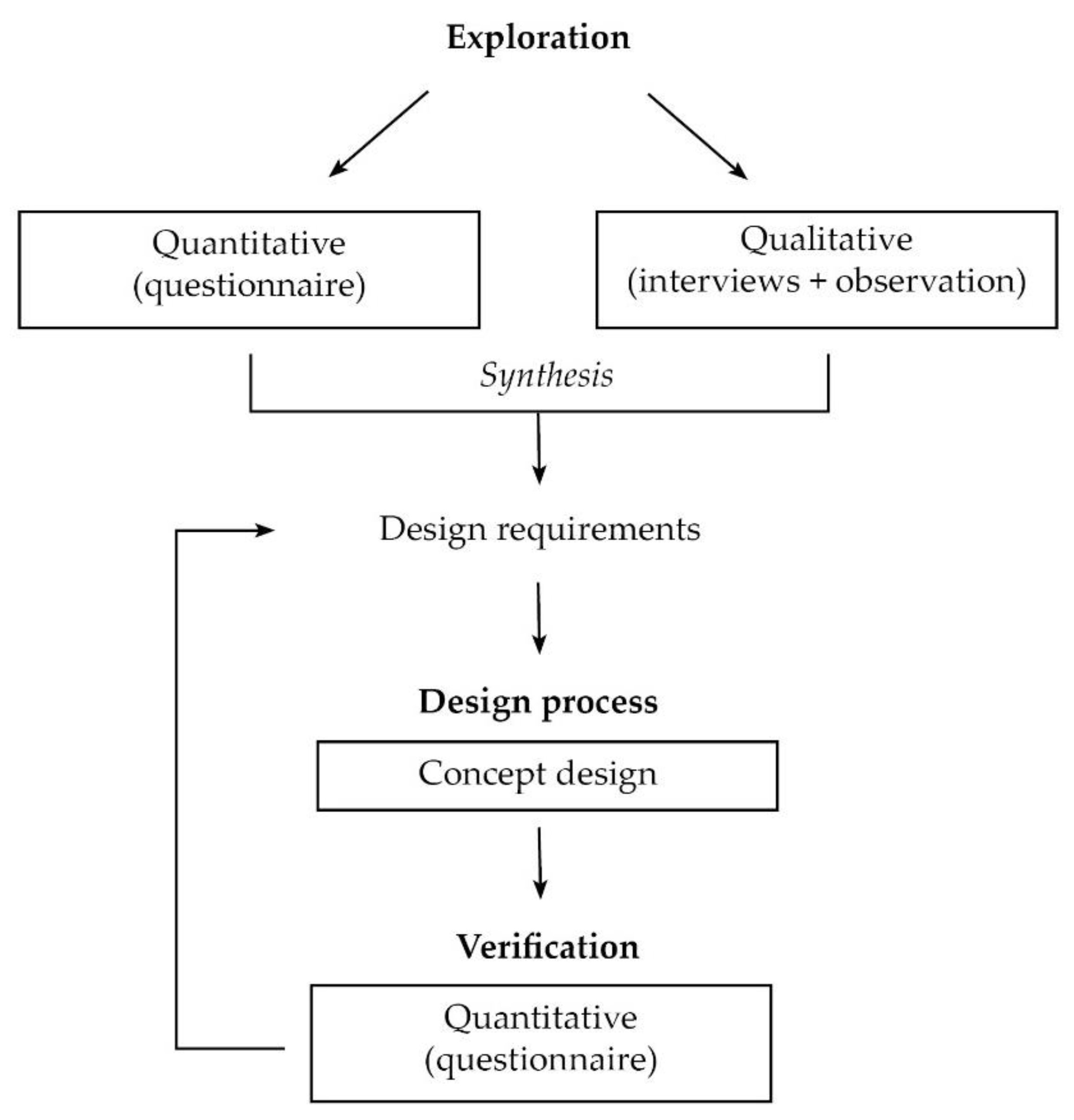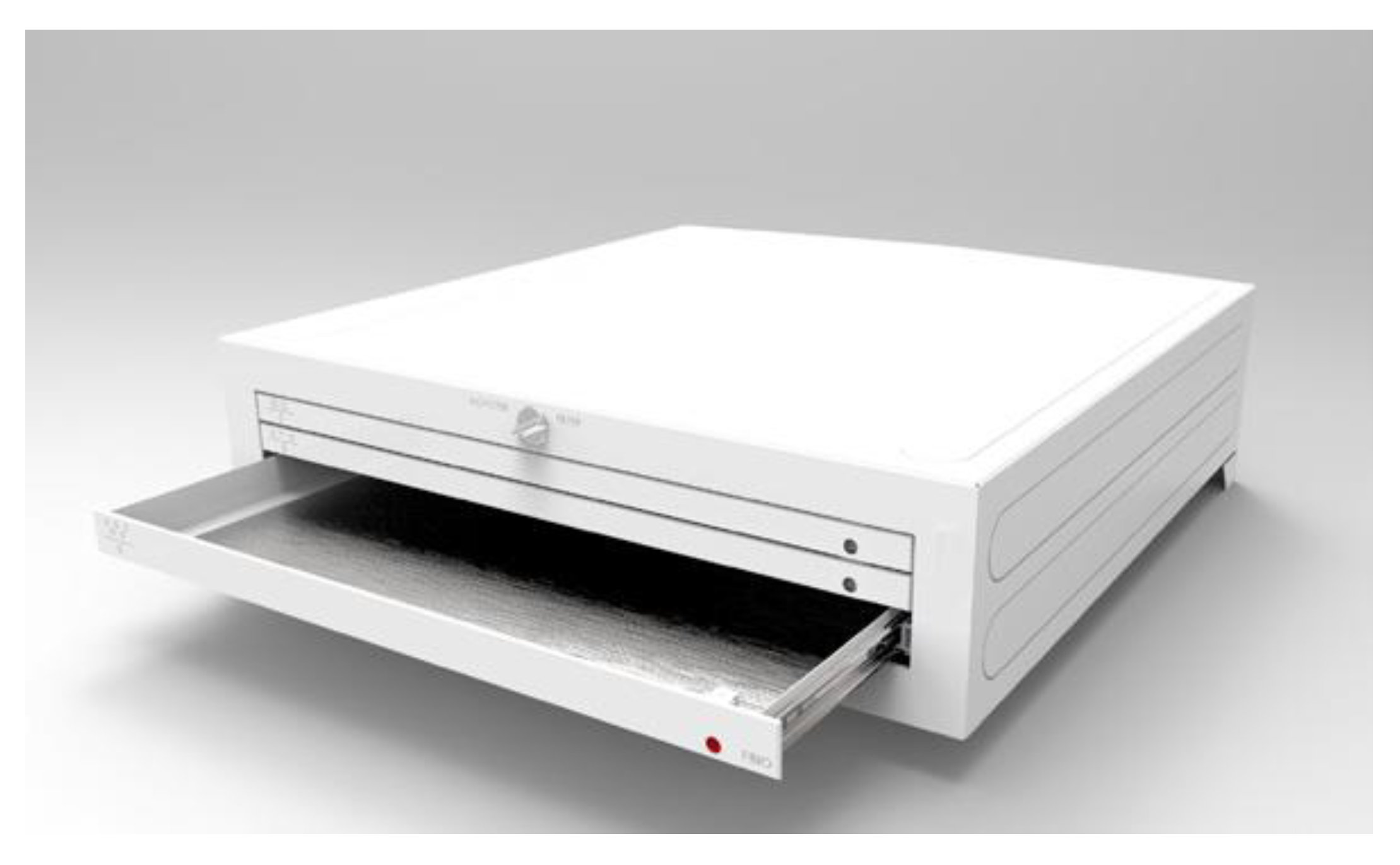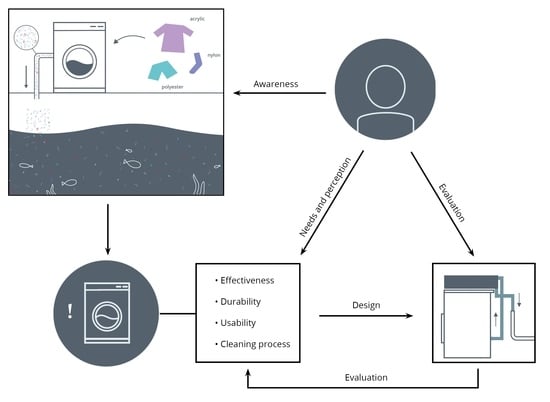Consumers’ Perceptions and Attitudes toward Products Preventing Microfiber Pollution in Aquatic Environments as a Result of the Domestic Washing of Synthetic Clothes
Abstract
1. Introduction
1.1. Microfibers
1.2. Tackling Microfiber Pollution
1.3. Influence of Household Laundry
1.4. Outline
2. Materials and Methods
2.1. Explorative Research Approach
2.1.1. Quantitative Study with Survey
2.1.2. Products Included in This Research
- The Cora Ball (Vermont, USA) is inspired by the ability of corals to capture tiny particles from the water. It is placed in the washing machine tub with the clothes, where it captures released fibers. After washing, the fibers must be removed from the Cora Ball by hand. The products costs 29.99 euros, and independent research concluded it captures on average 26% of microfibers [26].
- The Guppyfriend (Germany) is a laundry bag in which the synthetic clothes are put during washing. A fine polyamide mesh captures the fibers. The fibers must be removed by hand after every wash cycle. The product costs around 30 euros.
- The Filtrol 160 (Maine, USA) is an external filter located at the drain of the washing machine. Every 8 to 15 washing cycles the filter bag must be cleaned by turning the bag upside down, after the residue has had time to dry first. The manual suggests emptying the bag outside, thus spreading the microplastics into the environment. The bag will last 1–2 years. The complete product with one filter bag costs 120 euros and is only available in the United States of America. The main purpose of the Filtrol 160 is protecting the septic tank: capturing microfibers is an extra feature.
2.1.3. Qualitative Observation and In-Depth Interview
2.2. Design and Synthesis
2.3. Evaluation
3. Results
3.1. Explorative Quantitative Study
3.1.1. Consumer Awareness Regarding Microfiber Pollution and the Impact of Their Washing Habits
3.1.2. Evaluation of Existing Products
3.2. Explorative Qualitative Study
3.3. Preliminary Conclusion Based on the Exploration
- Besides providing a product, also information should be given. People need to be made aware of the problem and expand their knowledge.
- The most important property is visible effectiveness and proof that the solution works. Therefore, the visibility of the fibers and/or the contact of the users with the fibers seemed to be given as crucial arguments.
- Usability is the second most important factor, with a specific focus on convenience—(i) people should be able to wash all their clothes with the product, so they do not need to think about the textile material; (ii) people do not easily change their washing behavior; as such, if the effort would be too large, they would probably abandon the product and revert to their old washing routine.
- As the cleaning process is a new step in their washing habits, this phase should be easy and clear. People should not be able to do it the wrong way - as their first reaction is often to rinse it under the tap, which will allow the fibers to enter the wastewater again. Next, the process of cleaning should not require too much time or should not be necessary every time.
- Many respondents also want to know where the fibers will go after disposal, showing that the impact on the environment is very valuable, as can be concluded from the survey.
3.4. Synthesis and Design of the Product Concept
3.4.1. User-Related Design Requirements
- The operating and cleaning processes should be short and unambiguous;
- The product or marketing of the product should raise awareness of the problem;
- The product should be accessible from the front of the machine;
- The impact should be visible for the user(s), to keep them motivated;
- The scientifically proven effectiveness should be communicated objectively;
- The product should be durable and last for several years;
- The cleaning process should not rely on the visibility of the fibers;
- The location of the fibers should be clear to support optimal cleaning;
- Synthetic materials should not have to be selected or separated first;
- The product should be perceived as sustainable by itself (energy consumption, …);
- The product should allow a full load to be washed.
3.4.2. Concept Design
3.5. Evaluation of the Concept
4. Discussion
5. Conclusions
Author Contributions
Funding
Conflicts of Interest
Ethical Statement
References
- Essel, R.; Engel, L.; Carus, M.; Heinrich Ahrens, R. Sources of Microplastics Relevant to Marine Protection in Germany; Texte 64/2015; Federal Environment Agency: Umwelt Bundesamt, Germany, 2015.
- Wright, S.L.; Thompson, R.C.; Galloway, T.S. The physical impacts of microplastics on marine organisms: A review. Environ. Pollut. 2013, 178, 483–492. [Google Scholar] [CrossRef] [PubMed]
- Browne, M.A.; Crump, P.; Niven, S.J.; Teuten, E.; Tonkin, A.; Galloway, T.; Thompson, R. Accumulation of microplastic on shorelines woldwide: Sources and sinks. Environ. Sci. Technol. 2011, 45, 9175–9179. [Google Scholar] [CrossRef] [PubMed]
- Mishra, S.; Rath, C. Das charan, A.P. Marine microfiber pollution: A review on present status and future challenges. Mar. Pollut. Bull. 2019, 140, 188–197. [Google Scholar] [CrossRef] [PubMed]
- Salvador Cesa, F.; Turra, A.; Baruque-Ramos, J. Synthetic fibers as microplastics in the marine environment: A review from textile perspective with a focus on domestic washings. Sci. Total Environ. 2017, 598, 1116–1129. [Google Scholar] [CrossRef] [PubMed]
- Lecomte, M.; Janssen, C. De Verwijdering Van Microplastics in Rioolwaterzuiveringsinstallaties: Een Case-Study Voor Vlaanderen; Ghent University: Ghent, Belgium, 2015. [Google Scholar]
- Leslie, H.; Moester, M.; de Kreuk, M.; Vethaak, D. Verkennende Studie Naar Lozing Van Microplastics Door Rwzi’s. Available online: https://pure.tudelft.nl/portal/en/publications/verkennende-studie-naar-lozing-van-microplastics-door-rwzis(d980ca07-b54b-409a-a17d-bfa72b7655f8)/export.html (accessed on 28 January 2020).
- De Falco, F.; Gullo, M.P.; Gentile, G.; Di Pace, E.; Cocca, M.; Gelabert, L.; Brouta-Agnésa, M.; Rovira, A.; Escudero, R.; Villalba, R.; et al. Evaluation of microplastic release caused by textile washing processes of synthetic fabrics. Environ. Pollut. 2018, 236, 916–925. [Google Scholar] [CrossRef]
- Gago, J.; Carretero, O.; Filgueiras, A.V.; Viñas, L. Synthetic microfibers in the marine environment: A review on their occurrence in seawater and sediments. Mar. Pollut. Bull. 2018, 127, 365–376. [Google Scholar] [CrossRef]
- Cesa, F.S.; Turra, A.; Checon, H.H.; Leonardi, B.; Baruque-Ramos, J. Laundering and textile parameters influence fibers release in household washings. Environ. Pollut. 2020, 257, 113553. [Google Scholar] [CrossRef]
- Napper, I.E.; Thompson, R.C. Release of synthetic microplastic plastic fibres from domestic washing machines: Effects of fabric type and washing conditions. Mar. Pollut. Bull. 2016, 112, 39–45. [Google Scholar] [CrossRef]
- Resnick, B. More Than Ever, Our Clothes are Made of Plastic. Just Washing Them can Pollute the Oceans. Available online: https://www.vox.com/the-goods/2018/9/19/17800654/clothes-plastic-pollution-polyester-washing-machine (accessed on 20 January 2020).
- Ellen Macarthur Foundation. Completing the Picture How the Circular Economy Tackles Climate Change; Material Economics, 2019; p. 62. Available online: www.ellenmacarthurfoundation.org/publications (accessed on 20 January 2020).
- Pirc, U.; Vidmar, M.; Mozer, A.; Kržan, A. Emissions of microplastic fibers from microfiber fleece during domestic washing. Environ. Sci. Pollut. Res. 2016, 23, 22206–22211. [Google Scholar] [CrossRef]
- Petersson, H.; Roslund, S. En Undersökning av Polyesterplaggs Fiberutsläpp vid Hushållstvättning; The Swedish School of Textiles, University of Boras: Boras, Sweden, 2015. [Google Scholar]
- Zambrano, M.C.; Pawlak, J.J.; Daystar, J.; Ankeny, M.; Cheng, J.J.; Venditti, R.A. Microfibers generated from the laundering of cotton, rayon and polyester based fabrics and their aquatic biodegradation. Mar. Pollut. Bull. 2019, 142, 394–407. [Google Scholar] [CrossRef]
- Devriese, L.; Janssen, C. Overzicht van Het Onderzoekslandschap en de Wetenschappelijke Informatie Inzake Marien Zwerfvuil en microplastics in Vlaanderen; VLIZ Beleidsinformerende Nota’s Flanders; Vlaams Instituut voor de Zee (VLIZ): Oostende, Belgium, 2017; 26p, ISBN 978-94-92043-34-4. [Google Scholar]
- UNEP. Marine Plastic Debris and Microplastics: Global Lessons and Research to Inspire Action and Guide Policy Change; United Nations Environment Programme: Nairobi, Kenya, 2016; ISBN 978-92-807-3580-6. [Google Scholar]
- Lares, M.; Ncibi, M.C.; Sillanpää, M.; Sillanpää, M. Occurrence, identification and removal of microplastic particles and fibers in conventional activated sludge process and advanced MBR technology. Water Res. 2018, 133, 236–246. [Google Scholar] [CrossRef] [PubMed]
- Mintenig, S.M.; Int-Veen, I.; Löder, M.G.J.; Primpke, S.; Gerdts, G. Identification of microplastic in effluents of waste water treatment plants using focal plane array-based micro-Fourier-transform infrared imaging. Water Res. 2017, 108, 365–372. [Google Scholar] [CrossRef] [PubMed]
- Hartline, N.L.; Bruce, N.J.; Karba, S.N.; Ruff, E.O.; Sonar, S.U.; Holden, P.A. Microfiber Masses Recovered from Conventional Machine Washing of New or Aged Garments. Environ. Sci. Technol. 2016, 50, 11532–11538. [Google Scholar] [CrossRef] [PubMed]
- Henry, B.; Laitala, K.; Klepp, I.G. Microfibres from apparel and home textiles: Prospects for including microplastics in environmental sustainability assessment. Sci. Total Environ. 2019, 652, 483–494. [Google Scholar] [CrossRef]
- Nielsen The Dirt on Cleaning: Men Share More of the Load Than You Think. Available online: https://www.nielsen.com/lk/en/press-releases/2016/the-dirt-on-cleaning-men-share-more-of-the-load-than-you-think/ (accessed on 27 January 2020).
- Hernandez, E.; Nowack, B.; Mitrano, D.M. Polyester Textiles as a Source of Microplastics from Households: A Mechanistic Study to Understand Microfiber Release During Washing. Environ. Sci. Technol. 2017, 51, 7036–7046. [Google Scholar] [CrossRef]
- Sillanpää, M.; Sainio, P. Release of polyester and cotton fibers from textiles in machine washings. Environ. Sci. Pollut. Res. 2017, 24, 19313–19321. [Google Scholar] [CrossRef]
- McIlwraith, H.K.; Lin, J.; Erdle, L.M.; Mallos, N.; Diamond, M.L.; Rochman, C.M. Capturing microfibers—Marketed technologies reduce microfiber emissions from washing machines. Mar. Pollut. Bull. 2019, 139, 40–45. [Google Scholar] [CrossRef]
- Horváth, I. Differences between ‘research in design context’ and ‘design inclusive research’ in the domain of industrial design engineering. J. Des. Res. 2008, 7, 61–83. [Google Scholar] [CrossRef]
- Khalaj, J.; Pedgley, O. A semantic discontinuity detection (SDD) method for comparing designers’ product expressions with users’ product impressions. Des. Stud. 2019, 62, 36–67. [Google Scholar] [CrossRef]
- Goodman, L.A. Snowball sampling. Ann. Math. Stat. 1961, 32, 148–170. [Google Scholar] [CrossRef]
- Hair, J.; Money, A.H.; Samouel, P.; Page, M. Research Methods for Business; John Wiley and Sons: Chichester, UK, 2007; ISBN 9780470034040. [Google Scholar]
- Heo, J.; Muralidharan, S. What triggers young Millennials to purchase eco-friendly products: The interrelationships among knowledge, perceived consumer effectiveness, and environmental concern. J. Mark. Commun. 2019, 25, 421–437. [Google Scholar] [CrossRef]
- Kaiser, F.G.; Fuhrer, U. Ecological Behavior’s Dependency on Different Forms of Knowledge. Appl. Psychol. 2003, 52, 598–613. [Google Scholar] [CrossRef]
- Gardner, G.T.; Stern, P.C. Environmental Problems and Human Behavior; Allyn & Bacon: Needham Heights, MA, USA, 1996. [Google Scholar]
- Rozalia The Cora Ball. Available online: www.coraball.com (accessed on 5 January 2020).
- Waste, S.M. Guppyfriend. Available online: https://en.guppyfriend.com/ (accessed on 5 January 2020).
- Wexco Environmental Filtrol 160. Available online: https://filtrol.net/filtrol-160/ (accessed on 5 January 2020).
- Xeros XFiltra. Available online: https://www.xerostech.com/technology (accessed on 5 January 2020).
- Planet Care Planet Care Microfiber Filter. Available online: https://www.planetcare.org/en/ (accessed on 5 January 2020).
- Keppler, C.; Omo-Lamai, S. Fibrefree. Available online: https://www.jamesdysonaward.org/en-US/2017/project/fibrefree/ (accessed on 5 January 2020).
- Glaser, B.G.; Strauss, A.L. Discovery of Grounded Theory: Strategies for Qualitative Research; Routledge by Taylor and Francis: Abingdon Oxon, UK, 2017; ISBN 9780203793206. [Google Scholar]
- Locritani, M.; Merlino, S.; Abbate, M. Assessing the citizen science approach as tool to increase awareness on the marine litter problem. Mar. Pollut. Bull. 2019, 140, 320–329. [Google Scholar] [CrossRef] [PubMed]
- Herweyers, L.; FIBIO. Tackling Microplastic Fibre Pollution from Domestic Washing Machines; University of Antwerp: Antwerp, Belgium, 2018. [Google Scholar]
- A.I.S.E. Activity and Sustainability Report; International Association for Soaps, Detergents and Maintenance Products: Auderghem, Brussels, 2014. [Google Scholar]
- Kollmuss, A.; Agyeman, J. Mind the Gap: Why do people act environmentally and what are the barriers to pro-environmental behavior? Environ. Educ. Res. 2002, 8, 239–260. [Google Scholar] [CrossRef]



© 2020 by the authors. Licensee MDPI, Basel, Switzerland. This article is an open access article distributed under the terms and conditions of the Creative Commons Attribution (CC BY) license (http://creativecommons.org/licenses/by/4.0/).
Share and Cite
Herweyers, L.; Catarci Carteny, C.; Scheelen, L.; Watts, R.; Du Bois, E. Consumers’ Perceptions and Attitudes toward Products Preventing Microfiber Pollution in Aquatic Environments as a Result of the Domestic Washing of Synthetic Clothes. Sustainability 2020, 12, 2244. https://doi.org/10.3390/su12062244
Herweyers L, Catarci Carteny C, Scheelen L, Watts R, Du Bois E. Consumers’ Perceptions and Attitudes toward Products Preventing Microfiber Pollution in Aquatic Environments as a Result of the Domestic Washing of Synthetic Clothes. Sustainability. 2020; 12(6):2244. https://doi.org/10.3390/su12062244
Chicago/Turabian StyleHerweyers, Laure, Camilla Catarci Carteny, Linda Scheelen, Regan Watts, and Els Du Bois. 2020. "Consumers’ Perceptions and Attitudes toward Products Preventing Microfiber Pollution in Aquatic Environments as a Result of the Domestic Washing of Synthetic Clothes" Sustainability 12, no. 6: 2244. https://doi.org/10.3390/su12062244
APA StyleHerweyers, L., Catarci Carteny, C., Scheelen, L., Watts, R., & Du Bois, E. (2020). Consumers’ Perceptions and Attitudes toward Products Preventing Microfiber Pollution in Aquatic Environments as a Result of the Domestic Washing of Synthetic Clothes. Sustainability, 12(6), 2244. https://doi.org/10.3390/su12062244





